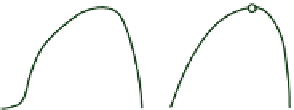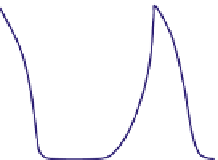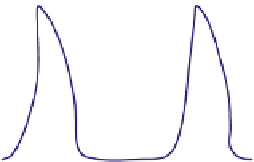Biomedical Engineering Reference
In-Depth Information
Therefore, the washout condition for the predator (while prey is not washed out) is
D k
dp
þ
m
p
max
YF
b=S
S
0
(16.92)
K
p
þ
YF
b=S
S
0
All washout (both prey and predator are washed out) condition can be obtained by first
setting X
p
¼
0 (prey washed out). Eqn
(16.88)
indicates that if prey is also being washed
out
d
X
b
d
t
< 0
,
>
m
b
max
S
K
b
þS
D
(16.93)
0.50
0.25
0
1.5
1.0
0.5
0
8
6
4
2
0
0
2
4
6
8
10
Time, days
12
14
16
18
20
FIGURE 16.21
Oscillations of the concentrations of substrate (glucose), prey (E. coli), and predator
(D. discotideum) with time in a continuous culture. Predictions based on
Eqns (16.87) through (16.89)
(lines),
superimposed on experimental data (symbols), for continuous culture with a residence time of 16 h or D
¼
0.0625/h
at 25
C. The kinetic parameters are given by k
dp
¼
0,
m
pmax
¼
0.24/h, K
p
¼
4
10
11
E. coli/L,
m
bmax
¼
0.25/h, K
b
¼
5
10
4
g/L, YF
p/b
¼
7.14
10
4
D. discoideum/E. coli,YF
b/S
¼
3
10
12
E. coli/g. Replotted from H. M. Tsuchiya, J. F.
Drake, J. L. Jost, and A. G. Fredrickson, “Predator-Prey Interactions of Dictyostelium discoideum and E. coli in Continuous
Culture”, J. Bacteriology. 110(3): 1147-1153, 1972.





















































































































































Search WWH ::

Custom Search